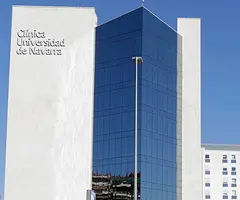Oesophageal cancer
"In most cases, oesophageal cancer is diagnosed in advanced stages. It is therefore essential to consult a doctor in case of any discomfort."
DR. JORGE BAIXAULI
SPECIALIST. GASTROINTESTINAL CANCER AREA

What is oesophageal cancer?
Oesophageal cancer is caused by the uncontrolled growth of cells in the innermost layer of this organ, giving rise to a mass or ulcer that progressively invades the different layers of the oesophagus.
The oesophagus is the tube that connects the throat to the stomach. Its main function is to transport food from the throat to the stomach for digestion.
There are two main types of tumours:
- Squamous or squamous epidermoid carcinoma: usually located in the middle and upper oesophagus.
- Adenocarcinoma: appears predominantly in the lower part of the oesophagus and is associated with conditions such as Barrett's oesophagus.
The Clínica Universidad de Navarra has a specialised Gastrointestinal Cancer Area, made up of specialists in digestive, endoscopy, general surgery, radiology, medical and radiotherapy oncology, nuclear medicine and pathological anatomy. This multidisciplinary team allows us to select individualised treatments for each patient.

A PERSONALIZED MEDICINE
Second Opinion,
peace of mind
Request a second opinion from our professionals with great experience in the diagnosis and treatment of oncological diseases
In 3 days, without leaving home.
What are the symptoms of oesophageal cancer?
Oesophageal cancer often does not cause symptoms until it is at an advanced stage, making early detection difficult. In advanced cases, the disease may lead to complete obstruction of the oesophagus.
Difficulty swallowing (dysphagia)
Sensation of food getting stuck in the throat or chest when swallowing, starting with solid foods and progressing to liquids.
Regurgitation
Involuntary backflow of food or liquid into the mouth, caused by blockage of the oesophagus.
Voice alterations
Voice changes, such as hoarseness or a weaker tone, due to involvement of the nerves near the oesophagus.
Unexplained weight loss
Unintentional weight loss that may be the result of difficulty eating or the metabolic effects of cancer.
Chest pain
Pain or a feeling of pressure in the chest area, which may radiate to the back.
Vomiting
Forced expulsion of food or liquid, especially if the obstruction of the oesophagus is severe.
Do you have any of these symptoms?
If you suspect that you have any of the above symptoms,
you should consult a medical specialist for a diagnosis.
What are the causes?
The main risk factors include high alcohol and tobacco consumption, the combination of which increases the risk multiplicatively.
There are also precancerous lesions, such as caustic oesophagitis, Barrett's oesophagus, achalasia or Plummer-Vinson syndrome.
Barrett's oesophagus, associated with gastro-oesophageal reflux and chronic hiatus hernia, is the most important predisposing factor.
Other risk factors include a diet poor in fruit and vegetables, consumption of very hot foods, and foods containing nitrosamines (present in products such as beer, fish and processed meats).
What is the prognosis?
Prognosis depends on factors such as the stage at diagnosis, the histological characteristics of the tumour, its location and extent, vasculolymphatic invasion and the patient's general condition.
Despite therapeutic advances, oesophageal cancer has a poor prognosis, with a five-year survival rate of less than 50% in localised tumours.
How is oesophageal cancer diagnosed?
Diagnosis begins with a thorough history and physical examination. If cancer is suspected, oesophagogastroscopy is performed to obtain images and tissue samples for biopsy.
To assess the extent of the disease, tests are used such as:
- Thoracic-abdominopelvic CT scan
- PET for staging
- Bronchoscopy
How is oesophageal cancer treated?
If the esophageal cancer is localized, a surgical approach is possible and the patient can be cured in a high percentage of cases. Surgical treatment aims at complete removal of the tumor and reestablishment of digestive transit. This intervention is called esophagectomy. Depending on the location of the tumor, surgery may require an approach through the abdomen, thorax and neck.
Currently, laparoscopic and thoracoscopic surgical techniques are being used in order to reduce the morbidity and mortality of surgical treatment.
In those patients with locally advanced disease, in order to reduce tumor size and favor adequate tumor resection, preoperative treatment is administered. This treatment consists of a combination of chemotherapy plus/minus radiotherapy.
It is important to bear in mind that due to the complexity of this intervention, it is essential to carry it out in specialized centers. The Clínica Universidad de Navarra has a highly qualified medical-surgical team to perform this procedure. In addition, we carry out a follow-up by the nursing service that helps to improve symptomatic control and favor the recovery of our patients.
Sometimes surgery or local techniques are used to alleviate or prevent symptoms related to the disease.
Some of these procedures are:
- Percutaneous gastrostomies or jejunostomies: is the placement by endoscopy of a tube or tube in the stomach (gastrostomies) or jejunum (jejunostomies) through the abdominal wall.
- Esophageal balloon dilation: with this procedure an attempt is made by inserting a small device to push through the narrowed area to stretch it.
- Placement of an esophageal prosthesis (stent).
- Electrocoagulation (electrofulguration): with this procedure a probe is passed into the esophagus through an endoscope to burn the tumor with electric current.
- Laser ablation: consists of directing a laser beam through the endoscope to destroy the cancerous tissue.
- Photodynamic therapy: this technique consists of the intravenous administration of a light-activated drug (photofrin). In the following days, the drug will accumulate in the cancerous cells, at which time a special type of laser light must be directed through the endoscope.
Chemotherapy is the medical treatment that consists of the application of chemical substances to the organism. It is mainly administered intravenously or orally, although there are other less common forms of administration.
Sometimes it is necessary to place a device called a port-a-cath. Treatment is prescribed according to a specific schedule depending on the regimen chosen. Prior to the administration of the medication, an assessment of the patient and an analytical determination must be made. Each administration is called a cycle, with the possibility of each cycle being divided into several sessions.
Depending on the moment of the administration of the treatment it is called:
- Neoadjuvant treatment: is the administration of chemotherapy prior to possible surgery. The objective is to reduce the size of the tumor and thus facilitate surgery.
- Adjuvant treatment: is the administration of chemotherapy after surgical resection. The objective is to eliminate possible microscopic disease in order to avoid recurrence of the disease.
- Palliative treatment: is the administration of treatment in a palliative manner. The intention is to reduce the burden of the disease and thereby derive a clinical benefit.
The Department of Medical Oncology of the Clínica Universidad de Navarra has a specialized area nurse who is in permanent contact with the patients to minimize the side effects derived from the medication. In addition, a telephone follow-up is carried out during treatment to detect possible toxicities and alleviate them in an early and effective manner.
Biological therapies are substances that are produced by living organisms. This substance is produced either naturally in the organism or in the laboratory. From an oncological point of view, there are different biological therapies, each of which has the function of stimulating or inhibiting the immune system.
Other types of biological therapies attack cancer cells in a specific way because they have a specific characteristic, such as monoclonal antibodies.
Immunotherapy is another type of biological therapy. These substances are used to stimulate or inhibit the immune system and thus help the body fight cancer.
Radiotherapy is a fundamental part in the management of esophageal cancer, either before definitive surgery or as an exclusive treatment combined with chemotherapy. The location of the esophagus, surrounded by important structures such as the heart, lungs or spinal cord, makes it very important to treat with the utmost precision. Combinations of external irradiation with brachytherapy, or, in the best of scenarios, treatments with proton therapy, achieve the best results both in terms of cure and tolerance.
The Clínica Universidad de Navarra has a Proton Therapy Unit. This therapy, due to its lower toxicity, is especially indicated for the treatment of tumors that are difficult to access or close to organs at risk.
In esophageal cancer, radiotherapy is used either in combination with chemotherapy in patients with locally advanced disease preoperatively or adjuvantly after surgery with risk factors.
In patients with advanced disease it can be an effective therapy for pain relief (antalgic radiotherapy), bleeding (hemostasis radiotherapy) or local control.
In addition to all of the above, we must not forget the emotional aspect of cancer patients.
At the Clínica Universidad de Navarra we have the possibility of carrying out a joint evaluation with the Palliative Medicine Service in order to achieve an adequate symptomatic management as well as the possibility of expressing and orienting the possible emotional effects that this disease causes in the patient and his family.
The combination of an adequate symptomatic and emotional control has shown a better tolerance to medication and a better coping with the adverse events that occur during the evolution of this process.
Proton therapy for cancer
Proton therapy is the most precise external radiotherapy modality, providing better distribution of radiation dose and therefore less irradiation of healthy tissues.
The Proton Therapy Unit of the Cancer Center Clínica Universidad de Navarra in its Madrid headquarters is the most advanced in Europe and the first in a Cancer Center, with all its healthcare, academic and research support.
Where do we treat it?
IN NAVARRA AND MADRID
The Gastrointestinal Cancer Area
of the Cancer Center Clínica Universidad de Navarra
The Gastrointestinal Cancer Area is composed of a multidisciplinary team of experts in the diagnosis and treatment of diseases of the digestive tract.
It includes specialists in the digestive system, radiology, pathological anatomy, surgery and medical and radiotherapeutic oncology and nursing support.
What diseases do we treat?

Why at the Clinica?
- Integral evaluation of the patient.
- Cutting edge technology.
- Expert professionals who are a national reference.






































